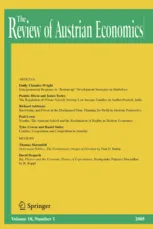- | Academic & Student Programs Academic & Student Programs
- | Financial Markets Financial Markets
- | Essays Essays
- |
Market Monetarism: Roadmap to economic prosperity
Marcus Nunes and Benjamin Cole
Originally published in The Review of Austrian Economics
Market Monetarism: Roadmap to Economic Prosperity is a re-examination of post-World War II economic history, focused mainly on the United States but also including cases such as the infamous Japanese "Lost Decade," from an explicitly market monetarist perspective.

Market Monetarism: Roadmap to Economic Prosperity is a re-examination of post-World War II economic history, focused mainly on the United States but also including cases such as the infamous Japanese "Lost Decade," from an explicitly market monetarist perspective. The rise of the Market Monetarism School is a recent phenomenon, coming to prominence mainly through debate in the blogosphere rather than academic conversation in the scholarly journals. Famous for its insistence that (1) nominal spending, meaning nominal gross domestic product (NGDP), is the curical variable determining macroeconomic stability and thus (2) central banks ought to implement an NGDP level target, Nunes and Cole adopt this framework to shed light on the causes of macroeconomic fluctuations up to an including the Great Recession. The book is written to be intelligible to those with only a minimal familiarity with modern macroeconomic theory, through an understanding of Aggregate Supply/Aggregate Demand analysis. The book consists of nine chapters, with the first outlining the Market Monetarist paradigm, the second providing the theoretical framework, the next six examining specific historical cases, and the last chapter ending with an argument for a radical reconsideration of what tools ought to make up a central banks' standard toolkit in conducting monetary policy, and the place of the central bank in a nation's system of governance.
Find the article at SpringerLink and SSRN.
To speak with a scholar or learn more on this topic, visit our contact page.

